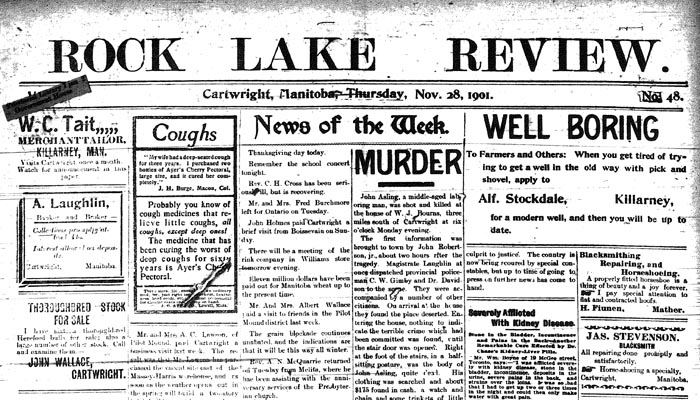Growing up in the village of Cartwright, Manitoba, I always knew there had been a murder. I knew that, about a hundred years ago, one man had fired a gun, and that another man had died after being struck with the ensuing projectile. I knew that there was a brief snippet about it in the town history book, and that, if you went to the local museum, you could look at a piece of paneling riven to splinters by a bullet that went astray during the incident.
No one I knew in Cartwright ever talked about the murder. I always found it a bit unusual, especially considering it’s likely the only murder the town will ever see. So, as a kid, I made up my own murder story, something fitting for the apathy with which most spoke of it.
My version went like this:
The men were out for a night of drinking. Eventually, they ended up on the street, one man pulled out his gun to have a bit of fun, and then, firing off rounds like a drunken Yosemite Sam, accidentally ricocheted a bullet into the chest of another man—a fatal wound.
This was my fabrication. It was simple, but it worked. I wasn’t aware of any living descendants of those involved in the incident, so it made sense that the story would have drifted into obscurity.
And then, last Thursday, with the help of Vicki Wallace, the editor of the local Cartwright paper, I tracked down a reel of microfilm at the Archives of Manitoba containing the November 28, 1901 edition of the Rock Lake Review, and the stories it told were a far cry from my own version of reckless tomfoolery.

Though both versions of the murder story were included in the same edition of the paper, only the first was written by the editor of the Rock Lake Review; the second was part of a print-ready package out of Winnipeg, and the two stories conflicted on several details, such as what time in the evening the incident took place and who the murderer had originally threatened to kill.
Hoping to clarify some of the story’s fuzzier details, I called home, and was soon informed that one of my former neighbours from Cartwright, Henry “Tiny” Bourns, was the son of William J. Bourns, the only person besides the murderer who knew the full story of what happened that night.
Bourns, still impressively sharp for a man of his age, not only explained to me what happened that night, but why everyone involved reacted the way that they did, something the newspaper reports had, for the most part, failed to achieve.
I’m far from bold enough to state that the following story is the truth of what happened on that cold, prairie night on the outskirts of Cartwright, Manitoba; reporting in 1901 was held to a different set of standards, and any first-hand knowledge has been taken to the grave. But, despite its untenable accuracy, this is the story we’re left with and, personally, I think it’s a pretty damn good one.
THE SHOOTING OF JOHN ASLING
It was November 26, 1901 when the man on the white horse rode into the yard of William J. Bourns. The sun had only just set, and Bourns was still out working in the yard. The road passed through the middle of the homestead, and when the man reached the spot where Bourns was working, he stopped and got down from his horse. He was of medium height with a solid build, and everything about him was a shade darker than the men Bourns was used to seeing, from his drab clothes to his black moustache and Métis complexion.
In broken English, he asked Bourns where the Wright family lived, and Bourns pointed west. He told the man the Wright homestead was only another mile down the road. It was then that the man drew two .44 Magnums and leveled them on Bourns.
“Your life or your money.”
Bourns told the man he was only carrying 25 cents, so the man directed him toward his home to collect more. When Bourns entered with the armed man in tow, his mother and sister were at the kitchen table, drinking their evening tea. Nearby sat the peddler John Asling, a traveling salesman of needles and other rare knickknacks, who was staying with the Bournses for the night.
Asling quickly deduced what was happening, and fled for a door that opened to an ascending staircase. Presuming Asling was attempting to escape out a second exit, the man turned and fired a shot, which entered the right half of Asling’s back and angled out on the left side of his chest. The man then turned on Bourns, who had leaped behind his wood stove, and fired several shots in his direction. Though the bullets missed Bourns, the concussion waves from the .44 Magnum blasted out the flames from the nearby lamps, leaving everyone in darkness. Unable to detect his victims, the man retreated out the front door, and was last seen riding west into the blackness.
By the time the Bournses had re-lit the lamps, John Asling was already dead. When the provincial policeman and local doctor examined him, they found a few trinkets, a watch and chain, and $175 in cash, a sum equivalent to more than $4,500 today.
Supposing the man came from a Métis settlement near St. John, North Dakota, word was immediately sent across the border. For weeks, a fleet of constables scoured Rolette County in search of the murderer, but they never did find the mysterious man who rode the white horse–the man who committed the only murder in the history of the village of Cartwright.
—
Mark Schram grew up on a ranch in southwestern Manitoba and now writes out of Winnipeg. If you would like to offer him a job or ask him about how to pull a calf, you can contact him at markcschram@gmail.com.
